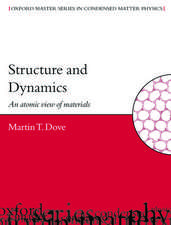Bond-Orientational Order in Condensed Matter Systems: Partially Ordered Systems
Editat de Katherine J. Strandburg Cuvânt înainte de D. R. Nelsonen Limba Engleză Paperback – 17 oct 2011
Preț: 394.29 lei
Nou
Puncte Express: 591
Preț estimativ în valută:
75.44€ • 78.78$ • 62.30£
75.44€ • 78.78$ • 62.30£
Carte tipărită la comandă
Livrare economică 15-29 aprilie
Preluare comenzi: 021 569.72.76
Specificații
ISBN-13: 9781461276807
ISBN-10: 1461276802
Pagini: 404
Ilustrații: XII, 388 p.
Dimensiuni: 155 x 235 x 21 mm
Greutate: 0.56 kg
Ediția:Softcover reprint of the original 1st ed. 1992
Editura: Springer
Colecția Springer
Seria Partially Ordered Systems
Locul publicării:New York, NY, United States
ISBN-10: 1461276802
Pagini: 404
Ilustrații: XII, 388 p.
Dimensiuni: 155 x 235 x 21 mm
Greutate: 0.56 kg
Ediția:Softcover reprint of the original 1st ed. 1992
Editura: Springer
Colecția Springer
Seria Partially Ordered Systems
Locul publicării:New York, NY, United States
Public țintă
ResearchCuprins
1 Bond-Orientational Order.- 1.1 Introduction.- 1.2 Elementary Ideas.- 1.3 Experimental Results.- 1.4 More Complicated Systems.- 1.5 Extensions to Three Dimensions.- References.- 2 Computer Simulation Studies of Bond-Orientational Order.- 2.1 Introduction.- 2.2 Numerical Simulation Techniques.- 2.3 Examples of Computer Simulation Studies of Bond-Orientational Order.- 2.4 Conclusions.- References.- 3 Nature of Phase Transitions Related to Stacked Hexatic Phases in Liquid Crystals.- 3.1 Introduction.- 3.2 Fundmental Properties of the Hexatic Phase.- 3.3 Thermal Properties.- 3.4 Criticality of the Smectic-A-Hexatic-B Transition.- 3.5 Conclusions.- References.- 4 Experimental Studies of Melting and Hexatic Order in Two-Dimensional Colloidal Suspensions.- 4.1 Introduction.- 4.2 Experimental Results—Melting of Two-Dimensional Colloidal Systems.- 4.3 Conclusions and Suggestions for Future Work.- References.- 5 Faceting in Bond-Oriented Glasses and Quasicrystals.- 5.1 Introduction.- 5.2 Quasicrystal Facets.- 5.3 The Conventional View of Facet Formation.- 5.4 Faceting in Perfect Bond-Oriented Systems.- 5.5 Equilibrium Shapes of Perfect and Random Quasicrystals.- 5.6 Final Remarks.- References.- 6 Icosahedral Ordering in Supercooled Liquids and Metallic Glasses.- 6.1 Introduction.- 6.2 Three-Dimensional Sphere Packings and Frustration.- 6.3 Structure Factor of Monoatomic Supercooled Liquids.- 6.4 Application to Real Metallic Glasses.- 6.5 Conclusions.- References.- 7 Orientational Order and Quasicrystals.- 7.1 Introduction.- 7.2 Bond-Orientational Order Parameter.- 7.3 Bond-Orientational Phase Diagram.- 7.4 Icosahedral Quasicrystals.- 7.5 Conclusion.- References.- 8 Icosahedral Glass Models for Quasicrystals.- 8.1 Introduction.- 8.2 Icosahedral Crystals and Quasiperiodicity.-8.3 Survey of Quasicrystalline Models for the Icosahedral Phase.- 8.4 Icosahedral Glass Structures.- 8.5 The Decagonal Glass in Two-Dimensions.- 8.6 The Icosahedral Glass in Three Dimensions.- 8.7 The Success and Failure of the Icosahedral Glass Model: Comparison with Experiments.- 8.8 Concluding Remarks.- References.




























